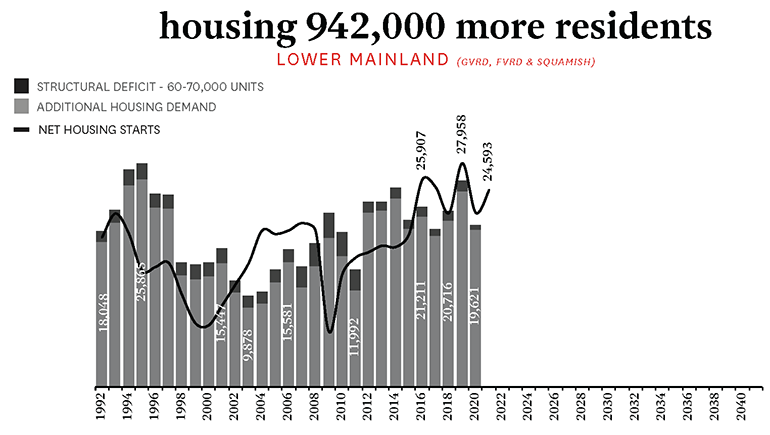Making homes more affordable – a round table on housing supply and affordability
At a glance (7 minute read)
- REBGV hosted a round table on affordable housing in January, with 230 members attending.
- The panelists identified supply as a key issue, offering solutions like streamlining building approval processes, zoning for ore density, and incentivizing construction.

Andrew Ramlo, vice-president advisory services, the Rennie Group
Total MLS® sales in the Lower Mainland have significantly declined in the past year. The key reason is a lack of supply.
The supply of homes (inventory) and the sales price are inextricably intertwined.
Wealth plays a role in driving up prices. Canadian parents gifted over $10 billion to help their children buy homes during the past year, with an average gift of $340,000, according to Benjamin Tal, CIBC deputy chief economist.
Canada expects to increase immigration to about 401,000 newcomers per year, 411,000 in 2023 and 421,000 in 2024. BC will receive about 15 per cent of these immigrants and most head to Metro Vancouver. The typical age of an immigrant is early-to-mid 30s, in prime home-buying years.
Canada has the lowest housing units per 1,000 residents of any G7 country.
By 2040, Metro Vancouver will have to house, 942,000 more residents. To accommodate these newcomers, 30,000 new units must be built each year.
Andrew Ramlo’s key insight: we need to add housing supply at a rate of 20 to 30 per cent above recent levels.
Click here for Andrew Ramlo's presentation

Joy MacPhail, chair, Expert Panel on the future of Housing Supply and Affordability
In 2019, federal and provincial ministers assembled the expert panel on future of housing supply and affordability.
The goal of the six-member panel, chaired by former BC finance minister and current ICBC chair, Joy MacPhail, was to address BC’s severe affordability challenges for middle-income earners and families.
The panel’s June 2021 report, Opening doors: unlocking housing supply for affordability, offered 23 recommendations under five broad calls to action on how three levels of government – federal, provincial and local – can increase the supply and affordability of housing in BC.
These include:
- creating a planning framework that proactively encourages housing;
- reforming fees on property development;
- expanding the supply of community and affordable housing;
- improving coordination among and within all orders of government; and
- ensuring more equitable treatment of renters and home owners.
Recommendations
The panel recommended the BC government:
- Impose time limits to all stages of the property development process, municipal or other, for all types of development.
- Require local governments to use anticipated growth numbers from the Housing Needs reports to determine land-use policies and decisions.
- Require growing municipalities to have OCPs updated every five years, pre-zone land/ infrastructure to match changes and stop spot zoning.
- With local governments, implement ideas in the Development Approvals Process Review report (DAPR), regarding public hearings and public input.
- Require province-wide priorities to be reflected in OCPs including minimum density requirements and pre-zoned sites for market/non-market homes near transit.
- With the federal government, make new infrastructure investments conditional on OCPs, zoning bylaws and other local policies to allow for increased density and a mix of housing types.
- Develop a province-wide digital development permitting system.
- Ensure local governments designate and prioritize infrastructure needs and amenity preferences with costs generated through development charges, well in advance.
- Phase out community amenity contributions and expand the definition of development cost charges to include a wider list of infrastructure and amenities directly tied to growth.
- Conduct a full review of local government revenue sources and spending responsibilities.
- Ensure local governments offer density bonuses to affordable housing developers that receive federal and provincial construction and redevelopment funding.
A controversial recommendation included means testing or ending the Home Owner Grant.
The panel recommended the federal government together with the provincial government:
- make new infrastructure investments conditional on OCPs, zoning bylaws and other local policies to allow for increased density and a mix of housing types.
- create a municipal housing incentive program rewarding the creation of net new housing supply including compensation for displaced renters;
- independently or jointly create an acquisition fund so non-profit housing organizations can buy currently affordable housing properties at risk of being repriced or redeveloped into more expensive units.
- create a municipal housing incentive program rewarding the creation of net new housing supply wherever demand occurs.
The panel further recommended the federal government:
- make long-term funding commitments, as was done until the mid-1990s, rather than offering short-term capital grants.
- amend the Income Tax Act to enable charitable housing providers to widen the cross section of groups they serve beyond low-income, disabled and elderly households, allowing charities to undertake mixed-income housing developments.
- make changes to tax programs to bring the treatment of renters and home owners into closer alignment to help offset the favourable tax treatment of ownership.
A controversial recommendation included reviewing the federal capital gains exemption on principal residences.
Read the full report (opens 88-page pdf)
Coquitlam Mayor Richard Stewart
Every week, Mayor Stewart receives emails that say: “Stop building so much housing and find somewhere for my daughter to live.”
While Stewart believes local governments must listen to local voices, governments also must make decisions. Our region needs more housing, so we must make the decision to add density.
Currently, the region is maintaining an urban containment boundary. How do we continue to expand the range of housing in a region where land is limited?
In Coquitlam, land values have increased about 11 per cent per year since 1958.
How does the city build more affordable housing? Put it near transit stations and allow for bonus densities, according to Stewart.
A key problem in municipalities is that only current residents get to decide on the official community plan (OCP) which may limit new housing.
Stewart believes future residents should also get to decide. The city shouldn’t be beholden to those who don’t want their neighbourhoods to change. Those who come to public hearings are often opposed to any new projects.
Neighbouring Port Moody also hasn’t added much housing, which has put more pressure on Coquitlam, according to Stewart.
Currently Coquitlam has five revised neighbourhood plans around five transit stations, for a total of 22,000 new units coming on stream. This is 15 years’ worth of housing coming in at the same time. Of this, 20 per cent is rental. Of these, 20 per cent are non-market rentals.
In Coquitlam, much of the rental stock, three-story walk-ups, is 50 years old and near end of life. To spur housing, existing stock needs to be replaced. New units will be more expensive. This has to be worked out since affordable rentals are in such demand.
There’s a vital need for coordination between all levels of government, according to Stewart.
His goal is to have enough affordable housing so his children can stay in BC and your children too.
Questions and Answers
Q: How much of the forecast immigrants buy rather than rent?
A: Andrew Ramlo: About 75 per cent of immigrants (immigrated within the past five years) on their census forms stated they were renters. Of in-migrants (from other provinces), 60 per cent were renters.
Joy MacPhail: the expert panel found the same trend. On top of this – the foreign student element – is 90 per cent rental. It’s not student housing – it’s rentals. Vast majority live off campus in low to moderate rental housing.
Q: How can one jurisdiction do nothing for affordable housing and put pressure on next jurisdiction?
A: Mayor Stewart: there needs to be regional planning. There should also be incentives for cities like Coquitlam which plan for density.
Q: Will the Tri-cities ever be merged into a single jurisdiction?
A: Mayor Stewart: he's not a big fan of amalgamation. But given there are, for example, five firehalls in five jurisdictions, which is costly, he supports amalgamation in the Tri-cities. But he’s the only mayor of the five municipalities who thinks it’s a good idea.
Q: Are unauthorized suites included in numbers?
A: Mayor Stewart: Yes, the suites are included in the census counts. There’s a broad recognition they provide an affordable rental stock. Coquitlam has embraced secondary suites and carriage homes as much needed gentle density, and there’s more to come in Coquitlam. Many of the suites are occupied by the adult children of the home owner. We need building codes to be more flexible.
Q: A big supply obstacle is NIMBYism. How can this be dealt with?
A: Joy MacPhail: The expert panel recommends the public hearing process substantially change. The public hearing should be at the OCP level, not at a spot rezoning.